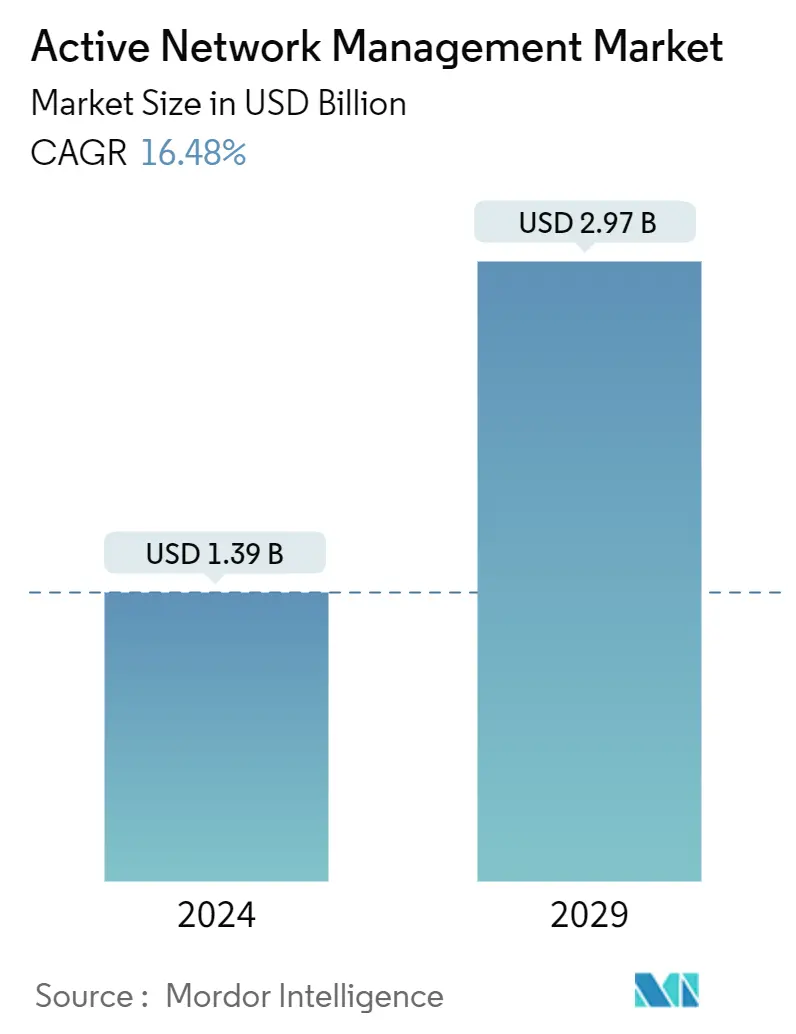Market Size of Active Network Management Industry

| Study Period | 2019 - 2029 |
| Market Size (2024) | USD 1.39 Billion |
| Market Size (2029) | USD 2.97 Billion |
| CAGR (2024 - 2029) | 16.48 % |
| Fastest Growing Market | North America |
| Largest Market | Asia Pacific |
Major Players
*Disclaimer: Major Players sorted in no particular order |
Need a report that reflects how COVID-19 has impacted this market and its growth?
Active Network Management Market Analysis
The Active Network Management Market size is estimated at USD 1.39 billion in 2024, and is expected to reach USD 2.97 billion by 2029, growing at a CAGR of 16.48% during the forecast period (2024-2029).
- Utilities are increasingly transitioning to cloud-based solutions for active network management market and grid asset monitoring due to the scalability, remote accessibility, and cost-efficient data storage and processing capabilities. Furthermore, utilities use artificial intelligence (AI) and data analytics to optimize grid operations. Active network management systems leverage predictive analytics to anticipate grid behavior and implement proactive measures. Grid asset monitoring also utilizes AI to predict maintenance needs and detect anomalies, thus contributing to the market's growth.
- The emerging Smart Grid technology will facilitate the shift to a low-carbon economy, and ANM systems will be required for power flow and voltage management. Huge investments need to be made toward electricity grids; around USD 600 billion in annual investment is required to achieve a net zero target by 2030. However, the investment process can be fast in emerging markets and developing economies, so electricity grids need to receive this necessary recognition and restrain the growth of the ANM market.
- According to the International Energy Agency (IEA), global electricity generation will rise by 2,493TWh between 2022 and 2025, leading to the growth in renewable generation that will cater to this demand. While Germany aims for 100% power generation from renewable resources by 2035, renewables are expected to be the most significant source of electricity within the next three years globally. Active network management systems will play a vital role in linking more distributed, renewable generation.
- The electrification of transportation, electric vehicles (EVs), necessitates active network management for the management of the charging infrastructure, as well as grid asset monitoring to evaluate the effect on grid assets. This step has been a driving factor in the expansion of the market. According to the Confederation of Indian Industry (CII), in July 2023, India may require at least 1.32 million EV charging stations by 2030 to facilitate the rapid uptake of electric vehicles. The government's strong support for electric vehicles has increased consumer choice and awareness, resulting in an exponential growth in EV adoption during 2022, with a threefold increase from the previous year.
- Active network management (ANM) systems collect and transfer sensitive information about network operations. It is essential to ensure the confidentiality and safety of this data. Rising concerns of data breaches or misappropriation may impede the adoption of Active network management (ANM) systems. Furthermore, in certain regions with rugged terrain or extreme weather conditions, implementing an Active network management infrastructure may be challenging and expensive, thus impeding the market's growth.
- Active network management (ANM) projects faced delays in the primary stages of the COVID-19 pandemic due to supply chain disruptions, labor constraints, and restrictions on-site visits and installation. These factors affected both ongoing and new projects. Subsequently, the COVID-19 pandemic highlighted the need for grid resilience, and the role of active network management in monitoring and responding to grid disruptions has become increasingly important in providing a dependable power supply, particularly during unexpected outages.
